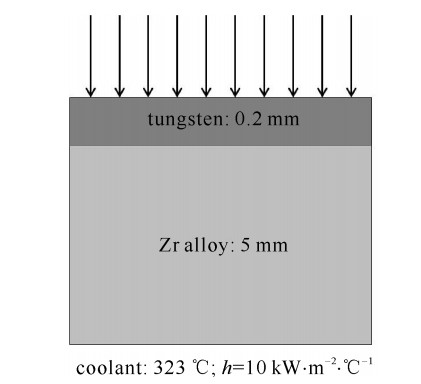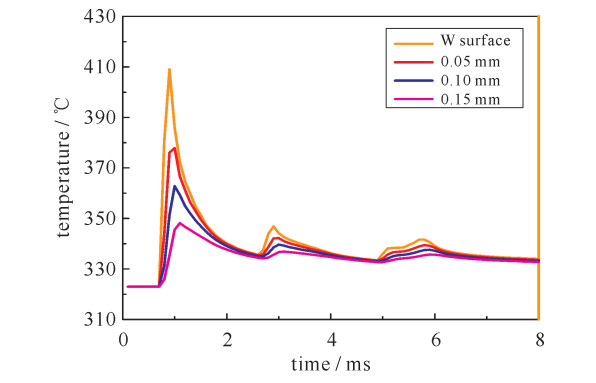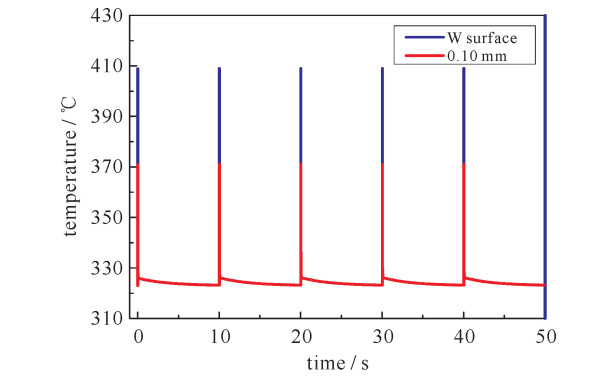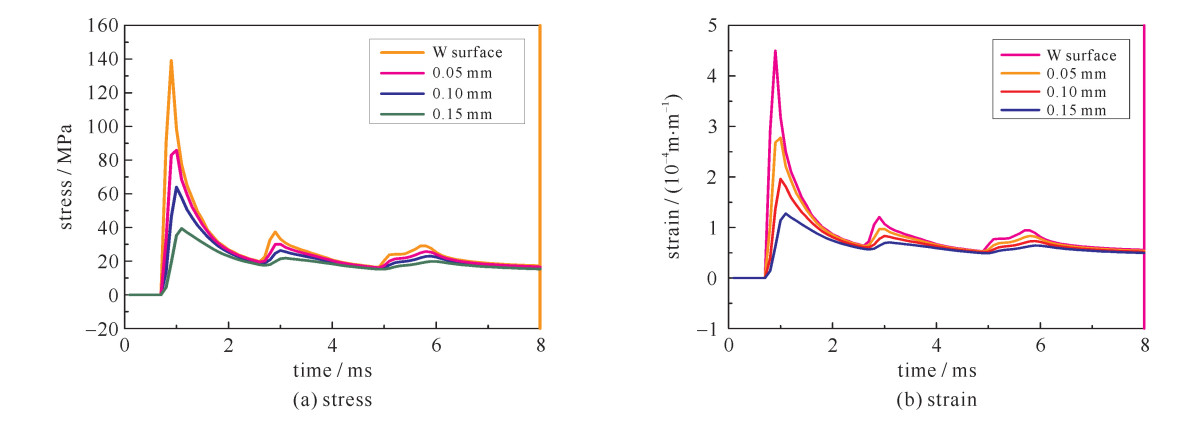Thermal-mechanical response analysis of the first wall in Z-pinch driven fusion-fission hybrid energy reactor
-
摘要: 利用ANSYS程序对Z箍缩驱动聚变-裂变混合堆(Z-FFR)第一壁在瞬态热流加载下的热-力学响应进行了模拟计算,分析了第一壁温度、应力随时间和深度的分布。结果表明,周期性脉冲加载不会导致第一壁产生温度累积效应,第一壁温度峰值409 ℃,出现在钨层表面,钨层最大应力140 MPa,锆合金基底最大应力33 MPa。Abstract: The simulation software ANSYS was used to calculate the thermal-mechanical response of the first wall in Z-pinch driven fusion-fission hybrid energy reactor under pulsed thermal flux, including distribution of temperature, stress and strain of the first wall materials along its depth direction. The results indicate that the periodic (10 s) transient pulse loading does not lead to the temperature accumulation in the first wall. The maximum temperature of the first wall appears on the surface of the tungsten coating. The maximum stress of the tungsten coating is 130 MPa. The maximum stress of the Zr alloy substrate is 33 MPa.
-
Key words:
- Z-FFR /
- first wall /
- thermal-mechanical responses /
- finite element analysis
-
表 1 钨层和锆合金的热物理参数
Table 1. Temperature-dependent properties of W and Zr alloy
material temperature/℃ density/(g·cm-3) Posison′s ratio thermalconductivity/(W·m-1·K-1) coefficient ofthermal expansion/(10-6 ·K-1) elastic module/GPa W 200 19254 0.28 155 3.93 397 400 19203 0.28 139 3.94 397 600 19151 0.28 127 3.95 396 Zr alloy 200 8895 0.34 341 17.5 128 400 8883 0.36 346 18.1 120 600 8860 0.38 349 18.6 109 -
[1] 李正宏, 黄洪文, 王真, 等. Z箍缩驱动聚变-裂变混合堆总体概念研究进展[J]. 强激光与粒子束, 2014, 26: 100202. doi: 10.11884/HPLPB201426.100202Li Zhenghong, Huang Hongwen, Wang Zhen, et al. Conceptual design of Z-pinch driven fusion-fission hybrid power reactor. High Power Laser and Particle Beams, 2014, 26: 100202 doi: 10.11884/HPLPB201426.100202 [2] 彭先觉, 王真. Z箍缩驱动聚变-裂变混合能源堆总体概念研究[J]. 强激光与粒子束, 2014, 26: 090201. doi: 10.11884/HPLPB201426.090201Peng Xianjue, Wang Zhen. Conceptual research of Z-pinch driven fusion-fission hybrid reactor. High Power Laser and Particle Beams, 2014, 26: 090201 doi: 10.11884/HPLPB201426.090201 [3] Wang Zenghui, Zhao Kaixuan, Chen Weiming, et al. Phase transformation research of fusion reactor first wall material tungsten[J]. Applied Thermal Engineering, 2013, 59(1/2): 498-503. [4] Zhu D H, Chen J L, Zhou Z J, et al. Thermal-mechanical analysis on W/CuCrZr plasma facing component with functionally graded material interlayer[C]// Symposium of the Tokamak Division of Institute of Plasma Physics, Chinese Academy of Sciences. 2013: 60-70. [5] Yang Z, Liu M, Deng C, et al. Thermal stress analysis of W/Cu functionally graded materials by using finite element method[J]. Journal of Physics: Conference Series, 2013, 419: 012051. doi: 10.1088/1742-6596/419/1/012051 [6] Hunt R M, Abbott R P, Havstad M A, et al. Fatigue cracking of a bare steel first wall in an inertial confinement fusion chamber[J]. Fusion Engineering & Design, 2013, 88(5): 311-316. [7] Blanchard J P, Martin C J. Thermomechanical effects in a laser IFE first wall[J]. Journal of Nuclear Materials, 2005, 347(3): 192-206. doi: 10.1016/j.jnucmat.2005.08.007 [8] Wang Y, Zhao J. Thermal-mechanical responses of the first wall in CFETR under transient events[J]. Journal of Fusion Energy, 2017, 36: 49-57. doi: 10.1007/s10894-017-0121-6 [9] Echols J R, Winfrey A L. Ablation offusion materials exposed to high heat flux in an electrothermal plasma discharge as a simulation for hard disruption[J]. Journal of Fusion Energy, 2014, 33(1): 60-67. doi: 10.1007/s10894-013-9639-4 [10] Qi J M, Wang Z, Chu Y Y, et al. Simulations of fusion chamber dynamics and first wall response in a Z-pinch driven fusion-fission hybrid power reactor (Z-FFR)[J]. Fusion Engineering & Design, 2016, 104(1): 61-70. [11] Preston S D, Bretherton I, Forty C. The thermophysical and mechanical properties of the copper heat sink material intended for use in ITER[J]. Fusion Engineering & Design, 2003, 68(3): 441-446. -





 下载:
下载:








